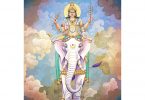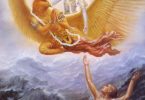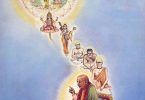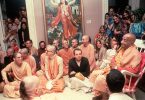Question: I read somewhere that Sun is the only material object that is self- illuminating in material world. But present day science says that all stars that we see in the sky are all self-illuminating and they are some times more powerful than the Sun in our solar system. Can you please give some insight on how planets are situated according to Vedic description?
Answer by Romapada Swami:
Yes, Srila Prabhupada makes this assertion based on the statements of Bhagavad-Gita and Bhagavatam. Krishna states in BG 10.21, “Among the stars I am the moon.” Also, in BG 13.34 and 15.12 He asserts that the sun alone illuminates the whole universe.
I took some direct assistance from Sadaputa Prabhu in responding to your question, and here is one paragraph extracted from what he wrote to me in reply:
“The Vedic literature describes the universe as having one sun, and the same is true of European cultural tradition up to the time of Copernicus and Galileo. Srila Prabhupada has granted that stars may have the same composition as the sun, and the story of Arjuna traveling to the region of the stars indicates that stars may shine with their own light. This agrees with the scientific observation that stars have an emission spectrum. If we define a sun to be a star illuminating inhabited planets, then our sun is the only such star that is known to science at the present time. (Indeed, the earth is the only planet known by science to have life.) In that sense, science knows of only one sun in the universe at the present time, even though many scientists tend to believe that there are other inhabited planets. (It is ironic that leading Darwinian evolutionists such as Theodosius Dobhzansky and George Gaylord Simpson have argued that human-like life must be limited to the earth due to the great improbability that it will evolve twice by the random Darwinian evolutionary process.)”
According to Vedic description, there are innumerable universes floating in the Causal Ocean, and each universe is enveloped by 7 layers of elemental matter. Thus everything visible to us, including all the stars, lie within the boundaries of our particular universe and there is only one sun within each universe. The Brahma samhita also says that sun is the eye of the universe.
Scientists conclude that the stars must be very far away and by the inverse square law of propogation of light they must be shining very brightly. Also, since it is observed that light from the stars show an emission spectrum, it must follow that they are actively generating light rather than passively reflecting it. Thus they deduce that the stars must be like the sun or more powerful. But as we discussed above, physical laws observed on earth cannot be assumed to hold universally.
Besides, although Prabhupada concluded that the stars derive illumination from the sun, this does not exclude the possibility of their generating their own light. The Mahabharata describes Arjuna traveling to the region of the stars, en route to heaven, and seeing the presiding denizens and sages of the stars shining with the effulgence of their ascetic merits. Similarly, Srila Prabhupada gives an ‘educated guess’ that there may be pleasing flames on the moon that generate illumination as they do in some regions of the Bhumandala. (SB 5.20.13 p) Prabhupada does also say that the stars may also have a similar composition as the sun, but they are not independent suns. (Letter to Svarupa Damodara dasa, Nov. 21, 1975)
See also SB 4.12.36 purport: “In the spiritual world the Vaikunthalokas are themselves illuminated; there is therefore no need of sun, moon or electric light. It is in fact the illumination of the Vaikunthalokas which is reflected in the material sky. Only by this reflection are the suns in the material universes illuminated; after the illumination of the sun, all the stars and moons are illuminated. In other words, all the luminaries in the material sky borrow illumination from Vaikunthaloka.”
See also descriptions such as found in the 4th Canto, where it is described that “the solar systems and other planets rotate, or circumabulate, around the Pole Star.” See SB 4.12.25. Reference is made, as you can see, to multiple solar systems.







